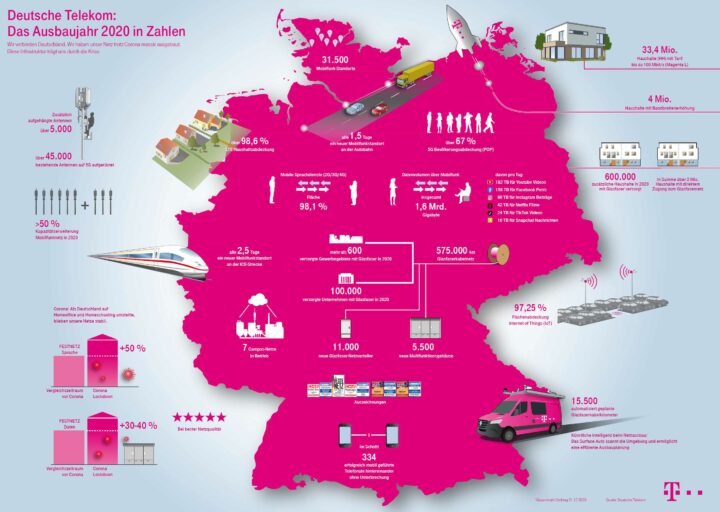
Deutsche Telekom has drawn a conclusion on its network expansion in 2020. Around 45,000 antennas have been made fit for 5G. In addition, 5,000 new antennas have made it into the network. If you look from the mobile to the landline network, fiber optics have been made possible for around 600,000 other households.
5G could now be used by 55 million people in Germany. As is so often the case, I have to consider: Taken in isolation, that says little, because the coverage in the area would be the more interesting value. According to Telekom, the 4G LTE network also increased in 2020 and now covers 98.6 percent of the population. In mobile communications as a whole, the data volume rose to a new high. In 2020, 1.6 billion gigabytes of data went through the network.
People in over 4,700 cities and towns could now use 5G. The majority of the antennas use the 2.1 GHz frequency. In addition, there is now 5G on the 3.6 GHz frequency in 26 cities. More than 1,000 antennas are in operation on this frequency. They operate in Aachen, Augsburg, Berlin, Bonn, Braunschweig, Bremen, Darmstadt, Dortmund, Duisburg, Düsseldorf, Essen, Frankfurt / Main, Hamburg, Hanover, Jena, Kiel, Cologne, Leipzig, Ludwigsburg, Munich, Nuremberg, Saarbrücken, Schwerin , Stuttgart, Wiesbaden and Wolfsburg. According to Telekom, every second contract or contract extension is currently concluded with a 5G device.


Overall, the company wants to provide around 80 percent of people in Germany with 5G by the end of 2021. In doing so, old 3G locations become 5G stations. All UMTS locations in Germany will be upgraded with 5G by mid-2021. In the few places where the anchor frequencies do not allow this, LTE comes.
Telephony use in 2021 was shaped overall by the Corona crisis: The call volume during the lockdown phase was on average around 50 percent above the otherwise common value, according to Telekom. The data volume in the fixed network also increased by an average of 30 to 40 percent. According to Telekom, a total of 33 million households in Germany could now book a connection with up to 100 Mbit / s. Around two million new fiber optic connections are to be added annually on average from 2021.
If you want to read these and other numbers again, then it may be worth taking a look in this PDF graphic.
–


